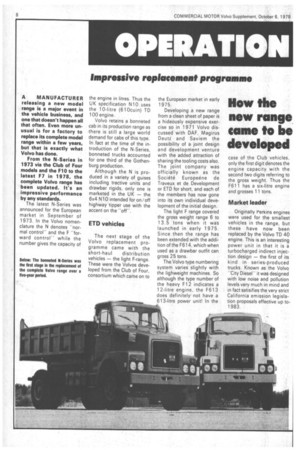How the new range came to be developed
Page 92

Page 93

If you've noticed an error in this article please click here to report it so we can fix it.
case of the Club vehicles, only the first digit denotes the engine capacity with the second two digits referring to the gross weight. Thus the F611 has a six-litre engine and grosses 11 tons.
Market leader Originally Ferkins engines were used for the smallest vehicles in the range, but these have now been replaced by the Volvo TD 40 engine. This is an interesting power unit in that it is a turbocharged indirect injection design — the first of its kind in series-produced trucks. Known as the Volvo "City Diesel" it was designed with low noise and pollution levels very much in mind and in fact satisifies the very strict California emission legislation proposals effective up to, 1983. Then in 1977 came the replacement for the F88/89 Series — for a long time One of the market leaders in Europe. Visually the big difference here was the new cab which is now right in with the best of them in the areas of driver comfort and safety. Volvo was the first to acknowledge that the old F 8 8 cab was getting a little long on the tooth, but the new cab certainly rectified that.
The Swedish impact regulations are notorious for their severity and consequently the new cab is very robust indeed. It is an all-steel design reinforced at knee level with a stiffened steel plate in the front panel. This plate covers the entire width of the cab and runs from the lower edge of the windscreen down to the cab floor, As if this were not enough, the doors have been reinforced with longitudinal steel pipes wh.ich fulfil two functions — they help to spread the load due to a frontal impact and provide .protection in the event of a side-on collision.
The TD 100 B is the mainstay of the F10 model being very familiar to the. many F88.owners. It has had the maximum engine speed dropped by 200 to 2,200rpm in the interests of fuel economy where it produces 207kVV (287bhp). The rest of the drive line is to the familiar Volvo specification includin.g the eight-speed full synchromesh gearbox with a splitter option giving 16 toward speeds. Although the basic box design is unchanged, the casing and the
bearings have been strengthened.
At the top of the heavy
weight Volvo range is the F12 which replaced the long-haul F89. This uses the 12-litre (432cuin) TD 120 C which produces 243kW (326bhp) at 2,200rpm.
Last link
So we come to the Latest of the new Volvos, the F7. Designed to replace the longserving F86, the F7 is the last link in the chain of the Volvo replacement programme. From the N-Series in 1973 to the F7 in 1978 — an impressive achievement.


























































































































































